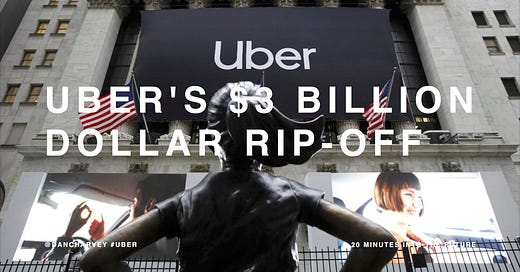Uber's $3 billion dollar magic trick
Hello from 20 Minutes into the Future. This week’s letter is 874 words, a 3 and a half minute read. Tonight we’ll be taking a critical look at the predatory practices behind Uber’s business model.

This post is part 2 of a series, Push a Button, Get a Car, Create Economic Injustice. In it, I’m exploring the exploitative nature of Uber’s business and its ramifications for the future. You can read the first post here if you'd like to get up to speed. Up now, how Uber uses VC cash to pursue monopolistic power. Buckle up.
People use Uber for many reasons. Cost is often cited as one of them. Barring surge pricing, people find Uber to be cheaper than taxis.
Those prices are artificially and unsustainably low. Uber uses its vast trove of VC funding to subsidize each ride. Who doesn't love value for money?
And while I'm all for sticking it to the VC crowd there's much more at stake. These subsidies are anti-competitive by design. This is a long-con at work.
Step 1: drive competition out of business
Step 2: develop vast monopolistic power in the process
Step 3: raise fees in the absence of any competition
Step 4: profit
That's why PR was so important to Uber from day one. The above could only work if they could show outsized demand in the marketplace. This is why Kalanick created a growth at any cost mindset at Uber.
And that's also why Travis Kalanick did everything in his power to NOT take the company public. He knew there was no way to get to actual profit without those subsidies, or in fact, at all subsidies or no. His dismissal from Uber is often portrayed as punishment for his misogyny but that's not true.
In truth it was because activist investors wanted out of these subsidies. They wanted to go public and cash out while they could. And many of them have.
And while Kalanick is long gone. Not much has changed under Khosrowshahi's watch. The company still
pursues unethical growth
subsidizes rides with VC cash
has no path to profit.
Companies like Amazon and Facebook have platform ahem monopoly power as a result of:
company size
industry dominance
protection against threats
use of platform ubiquity into other markets
Uber hasn't reached the sort of scale of Amazon or Facebook. And it's likely they never will. But they do have enough power to abuse their drivers.
Uber's marketing makes an awful lot of bullshit promises to their "driver-partners." Flexible working hours is one. That drivers made $90,000 a year was another. That claim was such a staggering lie that they had to pay a $20 million FTC settlement. While they've ceased making that particular claim they still overstate driver pay.
Here's an interesting before and after stat for you:
Before Uber: drivers earned $12 to $17 dollars an hour
After Uber: drivers earn $9 to $11 dollars an hour
That means Uber has driven pay well below minimum wage in most cases. There are countless stories from drivers about how they need to sleep in their cars to make ends meet. At least 20% of drivers need food stamps and other forms of public aid. You’re paying more for Uber than you think. And you’re doing it in the form of taxes.
Ad campaigns show artists and retirees who are opting for the job to supplement income. The truth is another matter altogether. 90% of drivers in NYC are new immigrants from Haiti, The Dominican Republic, India, etc.
What's more, one of Uber's revenue lines is loans to drivers to buy vehicles. Drivers often take out the loans based on lies of how much income they'll make. This undue financial obligation is the modern equivalent of indentured servitude.
Matters have gotten worse in recent years as Uber has exerted its market power over drivers. From 2010-2015 Uber ran many incentive programs to get drivers to sign on the bottom line. At the start Uber took a 20% cut of fares, that has since gone up to 30%. That move alone has resulted in a $3 billion transfer of wealth from labour to capital. Drivers weren't even made aware of the change.
File under: #uber #gigeconomy #businessmodels #economicinjustice
Next week: We’ll dig into how cities and the courts are fighting back.
Thanks for reading 20 Minutes into the Future. Have a friend or colleague who'd like the newsletter? Invite them to sign up. Any friend of yours is a friend of mine. Good night, and good future.
20 Minutes into the Future is a critical look at how technology is shaping our lives today. And what actions we can take for a better tomorrow. If you you're not already a subscriber and found this newsletter worth your while then please sign up.
Daniel Harvey writes 20 Minutes into The Future. He is a product designer and has written for Fast Company, Huffington Post, The Drum, & more. If you're pissed about the current state of tech and want to see us do better then you’ve found a kindred spirit.
You can email him at daniel.harvey@gmail.com or follow him on Twitter @dancharvey.



